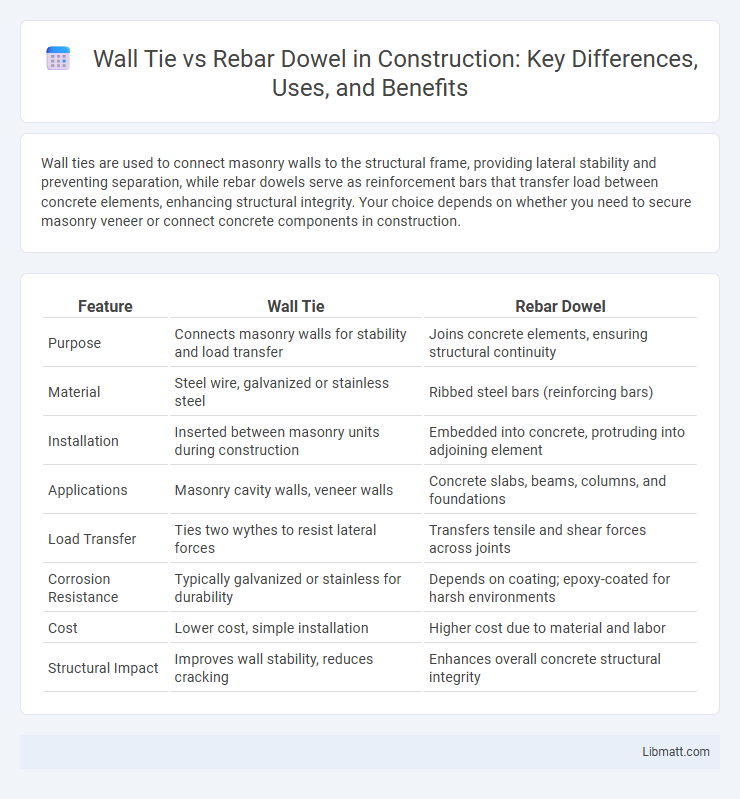Wall ties are used to connect masonry walls to the structural frame, providing lateral stability and preventing separation, while rebar dowels serve as reinforcement bars that transfer load between concrete elements, enhancing structural integrity. Your choice depends on whether you need to secure masonry veneer or connect concrete components in construction.
Table of Comparison
| Feature | Wall Tie | Rebar Dowel |
|---|---|---|
| Purpose | Connects masonry walls for stability and load transfer | Joins concrete elements, ensuring structural continuity |
| Material | Steel wire, galvanized or stainless steel | Ribbed steel bars (reinforcing bars) |
| Installation | Inserted between masonry units during construction | Embedded into concrete, protruding into adjoining element |
| Applications | Masonry cavity walls, veneer walls | Concrete slabs, beams, columns, and foundations |
| Load Transfer | Ties two wythes to resist lateral forces | Transfers tensile and shear forces across joints |
| Corrosion Resistance | Typically galvanized or stainless for durability | Depends on coating; epoxy-coated for harsh environments |
| Cost | Lower cost, simple installation | Higher cost due to material and labor |
| Structural Impact | Improves wall stability, reduces cracking | Enhances overall concrete structural integrity |
Understanding Wall Ties and Rebar Dowels
Wall ties secure masonry walls to structural frames, enhancing stability and preventing separation, while rebar dowels are steel bars embedded in concrete to reinforce joints and transfer loads between elements. Understanding the distinct purpose of wall ties versus rebar dowels is essential for ensuring the structural integrity of your building. Wall ties focus on lateral support, whereas rebar dowels primarily provide tensile strength in concrete connections.
Key Functions of Wall Ties
Wall ties serve as critical connectors that stabilize masonry walls by securely linking the outer brickwork to the inner structural frame, preventing bulging and maintaining structural integrity. Unlike rebar dowels, which primarily provide tensile reinforcement within concrete, wall ties manage lateral forces and distribute loads evenly across the wall assembly. Understanding the key functions of wall ties helps ensure your masonry structure remains durable and resistant to environmental stresses.
Primary Roles of Rebar Dowels
Rebar dowels serve as critical connectors that transfer shear loads between concrete slabs and structural elements, enhancing overall stability and load distribution. Their primary role involves providing reinforcement continuity across joints to prevent concrete cracking and structural displacement under stress. You can rely on rebar dowels to improve the durability and integrity of reinforced concrete constructions, distinguishing them from wall ties which mainly secure wall assemblies.
Material Composition Differences
Wall ties are typically made of galvanized steel or stainless steel, designed to resist corrosion and provide flexibility in masonry wall construction. Rebar dowels consist of high-strength carbon steel, often coated with epoxy to enhance durability and bonding within concrete structures. The key material difference lies in wall ties being flat or twisted straps for lateral support, whereas rebar dowels are rigid, ribbed bars optimized for load transfer and shear resistance.
Structural Application Comparison
Wall ties and rebar dowels serve distinct structural purposes in construction; wall ties primarily connect masonry walls to supporting structures, ensuring stability against lateral forces, while rebar dowels provide load transfer between concrete elements, enhancing tensile strength and continuity. Wall ties are essential in cavity wall systems to prevent separation, whereas rebar dowels are embedded within concrete joints to maintain alignment and resist shear stress. Understanding these functional differences helps you select the appropriate reinforcement method for your project's structural integrity and performance.
Installation Methods: Wall Tie vs Rebar Dowel
Wall ties are typically installed by embedding them directly into mortar joints during brick or block laying, ensuring lateral support between walls without requiring additional drilling. Rebar dowels require precise drilling into concrete or masonry followed by the insertion of steel bars with epoxy or grout for structural continuity and load transfer. Your choice depends on the structural needs and installation environment, with wall ties offering simpler integration and rebar dowels providing enhanced strength in reinforced applications.
Performance in Load Transfer
Wall ties and rebar dowels differ significantly in load transfer performance; wall ties primarily provide lateral load transfer between masonry and structural frames, ensuring stability and resistance to wind or seismic forces. Rebar dowels excel in transferring axial loads and moments across construction joints, offering enhanced structural continuity and tensile strength in concrete elements. Optimal load transfer depends on application context, where wall ties manage shear loads effectively, and rebar dowels maintain alignment and load-bearing capacity under compressive and tensile stresses.
Durability and Longevity
Wall ties offer moderate durability and are designed to resist corrosion when embedded correctly, ensuring the long-term stability of masonry walls. Rebar dowels provide superior strength and corrosion resistance due to their heavy-duty steel composition and protective coatings, significantly enhancing the structural longevity of concrete connections. Your choice between wall ties and rebar dowels should consider the environmental exposure and load requirements to maximize durability and lifespan.
Cost Considerations
Wall ties generally offer a more cost-effective solution compared to rebar dowels due to lower material and labor expenses. Rebar dowels require precise placement and additional labor for cutting, bending, and securing, which can increase overall project costs. Choosing wall ties can reduce construction time and material waste, optimizing budget efficiency on masonry wall projects.
Choosing Between Wall Tie and Rebar Dowel
Choosing between wall ties and rebar dowels depends on the structural requirements and material compatibility of masonry and concrete elements. Wall ties are optimal for connecting brick or block wall wythes, providing lateral stability and resistance to wind loads, while rebar dowels offer superior shear transfer and load-bearing capacity in concrete joints and foundations. Evaluating factors such as corrosion resistance, load type, and installation ease guides engineers in selecting the most effective connection method for reinforced masonry or concrete structures.
Wall tie vs rebar dowel Infographic

 libmatt.com
libmatt.com